
Placerville is a city in and the county seat of El Dorado County, California. The population was 10,747 as of the 2020 census, up from 10,389 as of the 2010 census. It is part of the Sacramento–Arden-Arcade–Roseville Metropolitan Statistical Area.
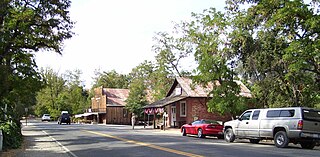
Coloma is a census-designated place in El Dorado County, California, US. It is approximately 36 miles (58 km) northeast of Sacramento, California. Coloma is most noted for being the site where James W. Marshall found gold in the Sierra Nevada foothills, at Sutter's Mill on January 24, 1848, leading to the California Gold Rush. Coloma's population is 529.

Marshall Gold Discovery State Historic Park is a state park of California, United States, marking the discovery of gold by James W. Marshall at Sutter's Mill in 1848, sparking the California Gold Rush. The park grounds include much of the historic town of Coloma, California, which is now considered a ghost town as well as a National Historic Landmark District. The park contains two California Historical Landmarks: a monument to commemorate James Marshall (#143) and the actual spot where he first discovered gold in 1848 (#530). Established in 1942, the park now comprises 576 acres (233 ha).

Christ Episcopal Church is an Episcopal congregation in South Pittsburg, Tennessee, part of the Episcopal Diocese of East Tennessee. The church building and parish house, located at 302 West 3rd Street, are listed on the National Register of Historic Places.

Old Donation Church is the third Lynnhaven Parish Church and is the oldest Episcopal Church in Virginia Beach. Records show that the parish's first church services were held in 1637 in the home of Adam Thoroughgood. The first church building was constructed on Mr. Thoroughgood's land in 1639 on the location later known as "Church Point." The vestry, or governing body of the church, was established in 1640.

The Church of Our Saviour, also known as the Church of Our Saviour at Mission Farm, the Mission of the Church of Our Saviour and the Josiah Wood, Jr., Farm, is an historic Episcopal church and farm complex located at 316 Mission Farm Road, in Killington, Vermont. The church is a Gothic Revival stone building, built in 1894-95 of Vermont granite. In addition to the church, the 170-acre (69 ha) Mission Farm property includes a c. 1817 farmhouse, a guest and retreat house, a vicarage, a bakery and agricultural buildings. On October 29, 1992, it was added to the National Register of Historic Places. The Church of Our Saviour is part of the Three Rivers Regional Ministry of the Episcopal Diocese of Vermont, and the Rev. Lee Allison Crawford is the vicar.

The Church of St. Luke and St. Matthew is a historic Episcopal church at 520 Clinton Avenue between Fulton Street and Atlantic Avenue in the Clinton Hill neighborhood of Brooklyn, New York City. This congregation was founded as St. Luke's Protestant Episcopal Church in 1842 following the failure of Trinity Church, which had been consecrated in the same building on June 1, 1835, by Bishop Onderdonk of the Diocese of Long Island. The founding of a church in this location resulted from the expansion of Brooklyn beyond initial European settlement in Brooklyn Heights. The building was constructed on a property consisting of eight city lots donated by George W. Pine.
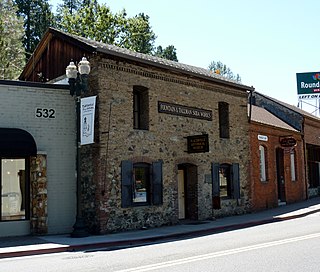
The Fountain-Tallman Soda Works is a historic building in Placerville, El Dorado County, California. It currently houses the Fountain & Tallman Museum, which is owned and operated by the El Dorado County Historical Society. The rustic vernacular Victorian stone and brick building, of the Gold Country, was placed on the National Register of Historic Places on September 13, 1984.
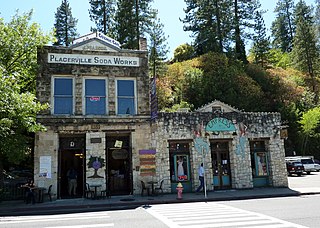
The John Pearson Soda Works, also referred to as the Placerville Soda Works, is a historic rustic vernacular Victorian brick building in Placerville, El Dorado County, California. The building, in the Gold Country region, was placed on the National Register of Historic Places (NRHP) on December 12, 1985. The building currently houses the Cozmic Café coffee shop.

Confidence Hall is a historic Italianate Style, Victorian brick building in Placerville, El Dorado County, California. The building was placed on the National Register of Historic Places (NRHP) on January 4, 1982.
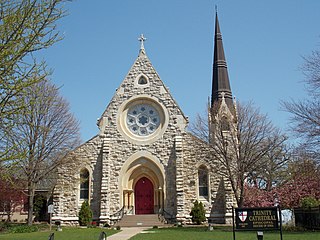
Trinity Episcopal Cathedral, formerly known as Grace Cathedral, is the historic cathedral in the Diocese of Iowa. The cathedral is located on the bluff overlooking Downtown Davenport, Iowa, United States. Completed in 1873, Trinity is one of the oldest cathedrals in the Episcopal Church in the United States. It was individually listed on the National Register of Historic Places in 1974. In 1983 the cathedral was included as a contributing property in the College Square Historic District, which is also listed on the National Register.

St. Mary of Ostrabrama is a historic Polish Roman Catholic church at the junction of Jackson Street and Whitehead Avenue in South River, Middlesex County, New Jersey, United States.
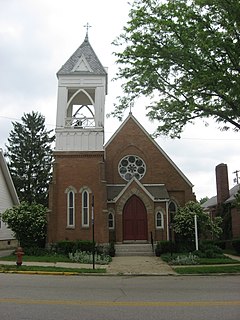
The Church of Our Saviour is a historic Episcopal parish in the village of Mechanicsburg, Ohio, United States. Founded in the 1890s, it is one of the youngest congregations in the village, but its Gothic Revival-style church building that was constructed soon after the parish's creation has been named a historic site.
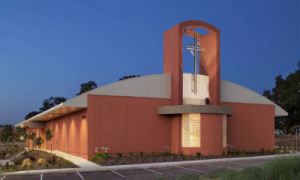
Faith Episcopal Church is located in Cameron Park, California, United States, adjacent to U.S. Route 50 in the California Gold Country foothills region. Parishioners come from Sacramento, Folsom, El Dorado Hills and the Placerville area. The parish is located in a modern church building completed in 2003, housing a congregation that started as a mission group in the home of Father Kent S. McNair. In the spring of 2001 Faith Church became a parish of the Episcopal Diocese of Northern California. Faith Church is one of the younger parishes in the Diocese.

St. John's Episcopal Church is a parish church in the Episcopal Diocese of Iowa. It is located in Keokuk, Iowa, United States. It was listed, together with the parish hall, on the National Register of Historic Places in 1989.

The Episcopal Church of the Saviour, also known as Memorial Episcopal Church, is a parish church in the Episcopal Diocese of Iowa. The church is located in Clermont, Iowa, United States. The church building, along with the statue of David Henderson, was listed on the National Register of Historic Places in 2000.

Trinity Episcopal Cathedral is an historic church building at 310 West 17th Street in Little Rock, Arkansas, United States. It is the seat of the Diocese of Arkansas and is listed on the National Register of Historic Places.

The All Saints Episcopal Church in Denver, Colorado, later known as Chapel of Our Merciful Saviour, is a historic church at 2222 W. 32nd Avenue. It was built in 1890 and was added to the National Register of Historic Places in 1978.
Christ Episcopal Church, or simply Christ Church, is an historic church building located in Burlington, Iowa, United States. It is a part of the Episcopal Diocese of Iowa, and is a contributing property in the Heritage Hill Historic District listed on the National Register of Historic Places.
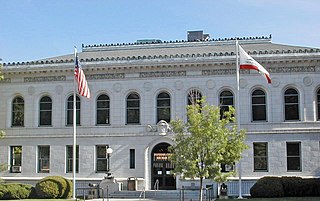
The Superior Court of California, County of El Dorado, also known as the El Dorado County Superior Court, is the branch of the California superior court with jurisdiction over El Dorado County.
























